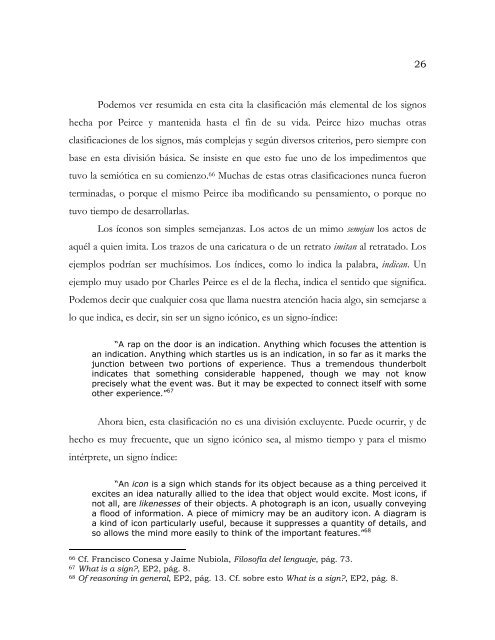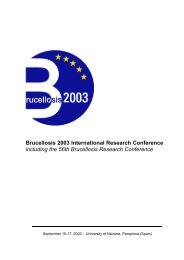Aportes filosóficos de Charles Sanders Peirce - Universidad de ...
Aportes filosóficos de Charles Sanders Peirce - Universidad de ...
Aportes filosóficos de Charles Sanders Peirce - Universidad de ...
Create successful ePaper yourself
Turn your PDF publications into a flip-book with our unique Google optimized e-Paper software.
26<br />
Po<strong>de</strong>mos ver resumida en esta cita la clasificación más elemental <strong>de</strong> los signos<br />
hecha por <strong>Peirce</strong> y mantenida hasta el fin <strong>de</strong> su vida. <strong>Peirce</strong> hizo muchas otras<br />
clasificaciones <strong>de</strong> los signos, más complejas y según diversos criterios, pero siempre con<br />
base en esta división básica. Se insiste en que esto fue uno <strong>de</strong> los impedimentos que<br />
tuvo la semiótica en su comienzo. 66 Muchas <strong>de</strong> estas otras clasificaciones nunca fueron<br />
terminadas, o porque el mismo <strong>Peirce</strong> iba modificando su pensamiento, o porque no<br />
tuvo tiempo <strong>de</strong> <strong>de</strong>sarrollarlas.<br />
Los íconos son simples semejanzas. Los actos <strong>de</strong> un mimo semejan los actos <strong>de</strong><br />
aquél a quien imita. Los trazos <strong>de</strong> una caricatura o <strong>de</strong> un retrato imitan al retratado. Los<br />
ejemplos podrían ser muchísimos. Los índices, como lo indica la palabra, indican. Un<br />
ejemplo muy usado por <strong>Charles</strong> <strong>Peirce</strong> es el <strong>de</strong> la flecha, indica el sentido que significa.<br />
Po<strong>de</strong>mos <strong>de</strong>cir que cualquier cosa que llama nuestra atención hacia algo, sin semejarse a<br />
lo que indica, es <strong>de</strong>cir, sin ser un signo icónico, es un signo-índice:<br />
“A rap on the door is an indication. Anything which focuses the attention is<br />
an indication. Anything which startles us is an indication, in so far as it marks the<br />
junction between two portions of experience. Thus a tremendous thun<strong>de</strong>rbolt<br />
indicates that something consi<strong>de</strong>rable happened, though we may not know<br />
precisely what the event was. But it may be expected to connect itself with some<br />
other experience.” 67<br />
Ahora bien, esta clasificación no es una división excluyente. Pue<strong>de</strong> ocurrir, y <strong>de</strong><br />
hecho es muy frecuente, que un signo icónico sea, al mismo tiempo y para el mismo<br />
intérprete, un signo índice:<br />
“An icon is a sign which stands for its object because as a thing perceived it<br />
excites an i<strong>de</strong>a naturally allied to the i<strong>de</strong>a that object would excite. Most icons, if<br />
not all, are likenesses of their objects. A photograph is an icon, usually conveying<br />
a flood of information. A piece of mimicry may be an auditory icon. A diagram is<br />
a kind of icon particularly useful, because it suppresses a quantity of <strong>de</strong>tails, and<br />
so allows the mind more easily to think of the important features.” 68<br />
66 Cf. Francisco Conesa y Jaime Nubiola, Filosofía <strong>de</strong>l lenguaje, pág. 73.<br />
67 What is a sign?, EP2, pág. 8.<br />
68 Of reasoning in general, EP2, pág. 13. Cf. sobre esto What is a sign?, EP2, pág. 8.
















